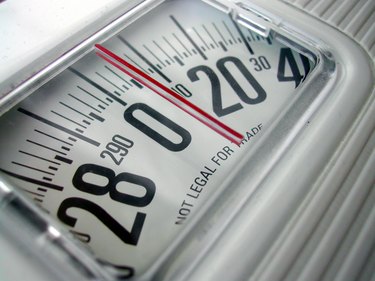
To lose weight, you need to burn more calories than you consume, says the Centers for Disease Control and Prevention. An 18-year-old can do this in one of two ways: eating fewer calories or exercising more. The best -- and healthiest -- choice is a combination of both. Follow a balanced diet that's low in sugar, fat, sodium and refined grains and get regularly involved in a physical activity that you enjoy. Ask your doctor or a dietitian for help if you're having trouble developing lifestyle habits that lead to sustainable weight loss.
Fill Up on Produce
Video of the Day
An 18-year-old shouldn't try to lose weight by starving herself or by going on fad diets that encourage eating only a few foods -- not only does disordered eating negatively affect her mental and physical health, it sets the stage for a lifelong battle with weight. Instead, he should base his daily meals on a variety of nutrient-dense, low-calorie options like fresh fruits and vegetables. An easy way to do this is to follow the U.S. Department of Agriculture's recommendation to fill half of your plate at each meal with produce. This strategy will help you eat less of other, higher-calorie items while still supplying needed vitamins and minerals. Have produce raw, steamed, grilled, roasted or broiled with as little added fat as possible.
Video of the Day
Control Your Protein and Carbohydrate Portions
You need lean proteins like poultry, seafood and tofu and carbohydrate-rich foods such as whole-wheat bread or whole-grain pasta every day, but if you eat too much, you'll have trouble losing weight. An 18-year-old should have between 6 and 8 ounces of grains each day. A 1-ounce serving is equivalent to a slice of bread, one corn or flour tortilla, 1 cup of breakfast cereal or 1/2 cup of cooked rice, noodles or other cereal grains like oatmeal. An 18-year-old needs around 5 to 6 1/2 ounces of protein -- one egg, 1/2 ounce of nuts or seeds, 1/4 cup cooked beans or legumes, or 1 ounce of cooked fish, poultry or lean meat count as one serving. Learning how to keep your portions within the recommended measurements can help you avoid unintentionally overeating.
Skip the Empty Calories
Sodas, sugary fruit punches or sugary coffee drinks, butter, lard, fried or fast foods, desserts and processed meats like hot dogs or pepperoni are all unhealthy sources of calories. Sodas and other items that are all or mostly sugar add to your daily calorie total without giving you any nutritional benefit. An 18-year-old girl should have no more than 160 empty calories per day, while a boy of the same age should have 265 or fewer. Reducing the amount of empty calories a teen eats regularly will make weight loss easier. Drink 100 percent fruit juice or water instead of beverages high in sugar and treat commercially baked goods and desserts as an occasional indulgence, not a daily necessity.
Find Time to Exercise
An 18-year-old boy or girl needs to engage in two types of regular physical activity to lose weight and stay healthy: moderate- or vigorous-intensity aerobic exercise and muscle-strengthening activities. He should aim each week for a total of 2 hours and 30 minutes of moderate-intensity aerobic exercise like brisk walking, 75 minutes of vigorous-intensity exercise such as running or a combination of both. Muscle-strengthening activities -- yoga or lifting weights, for example -- should be done at least two times weekly. Do all your exercising in a few long sessions or break it up over several days.
- Centers for Disease Control and Prevention: Balancing Calories
- Fruits & Veggies More Matters: MyPlate & What Is a Serving of Fruits and Vegetables? Fill Half Your Plate
- ChooseMyPlate.gov: Food Groups -- Welcome to the Five Food Groups
- ChooseMyPlate.gov: Calories -- What Are Empty Calories?
- Centers for Disease Control and Prevention: How Much Physical Activity Do Adults Need?